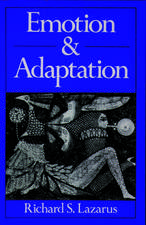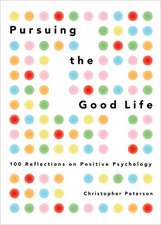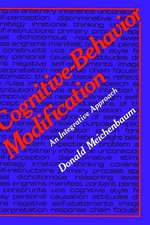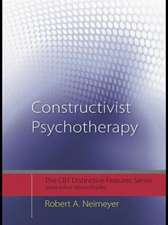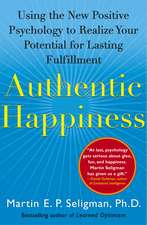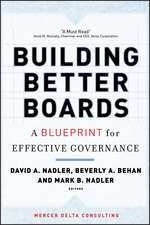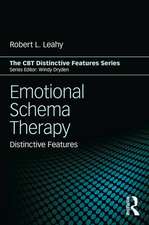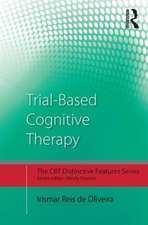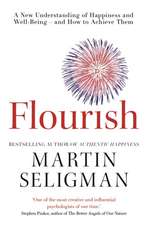Schema Therapy: Distinctive Features: CBT Distinctive Features
Autor Eshkol Rafaeli, David P. Bernstein, Jeffrey Youngen Limba Engleză Paperback – 3 sep 2010
| Toate formatele și edițiile | Preț | Express |
|---|---|---|
| Paperback (1) | 137.79 lei 3-5 săpt. | +6.61 lei 5-11 zile |
| Taylor & Francis – 3 sep 2010 | 137.79 lei 3-5 săpt. | +6.61 lei 5-11 zile |
| Hardback (1) | 656.10 lei 6-8 săpt. | |
| Taylor & Francis – 7 sep 2010 | 656.10 lei 6-8 săpt. |
Din seria CBT Distinctive Features
- 5%
 Preț: 137.56 lei
Preț: 137.56 lei - 5%
 Preț: 138.47 lei
Preț: 138.47 lei - 5%
 Preț: 137.80 lei
Preț: 137.80 lei - 5%
 Preț: 152.17 lei
Preț: 152.17 lei -
 Preț: 152.46 lei
Preț: 152.46 lei - 5%
 Preț: 159.04 lei
Preț: 159.04 lei - 5%
 Preț: 124.15 lei
Preț: 124.15 lei - 5%
 Preț: 123.42 lei
Preț: 123.42 lei - 5%
 Preț: 149.54 lei
Preț: 149.54 lei - 5%
 Preț: 123.24 lei
Preț: 123.24 lei - 5%
 Preț: 145.14 lei
Preț: 145.14 lei - 5%
 Preț: 144.72 lei
Preț: 144.72 lei - 5%
 Preț: 144.76 lei
Preț: 144.76 lei - 5%
 Preț: 159.40 lei
Preț: 159.40 lei - 5%
 Preț: 138.25 lei
Preț: 138.25 lei - 5%
 Preț: 145.22 lei
Preț: 145.22 lei - 17%
 Preț: 159.51 lei
Preț: 159.51 lei - 5%
 Preț: 146.74 lei
Preț: 146.74 lei - 22%
 Preț: 118.21 lei
Preț: 118.21 lei - 5%
 Preț: 145.14 lei
Preț: 145.14 lei - 22%
 Preț: 112.80 lei
Preț: 112.80 lei - 5%
 Preț: 124.87 lei
Preț: 124.87 lei
Preț: 137.79 lei
Preț vechi: 145.05 lei
-5% Nou
26.37€ • 27.43$ • 21.77£
Carte disponibilă
Livrare economică 24 martie-07 aprilie
Livrare express 08-14 martie pentru 16.60 lei
Specificații
ISBN-10: 0415462991
Pagini: 184
Ilustrații: 1 black & white illustrations, 1 black & white tables
Dimensiuni: 123 x 186 x 15 mm
Greutate: 0.18 kg
Ediția:1
Editura: Taylor & Francis
Colecția Routledge
Seria CBT Distinctive Features
Locul publicării:Oxford, United Kingdom
Public țintă
Postgraduate, Professional, and Professional Practice & DevelopmentCuprins
Part I: Theory. Universal Core Emotional Needs. Early Maladaptive Schema Development as a Consequence of Unmet Needs. A Taxonomy of EMS’s (Schemas). Coping Styles and Responses. Coping Styles: Surrender Responses. Coping Styles: Avoidance Responses. Coping Styles: Overcompensation Responses. Schema Modes as States (The State vs. Trait Distinction). The Wounded Core: Vulnerable Child Mode. Angry and Impulsive Child Modes. The Maladaptive Coping Modes. Internalized Parental Modes. Healthy Modes: Contented Child, Healthy Adult. Limited Reparenting. Empathic Confrontation. Part II: Practice. The Assessment Process: Focused Life History Interview, Schema Inventories, and Self-monitoring. The Assessment Process: Guided Imagery. The Assessment Process: The Therapy Relationship. Educating the Patient About the Schema and Mode Model, and Using the Schema Case Conceptualization Form. Toolbox 1: Relational Techniques. Toolbox 2: Cognitive Techniques. Toolbox 3: Emotion-focused Techniques. Toolbox 4: Behavioral Pattern Breaking. Mode Dialogues and Imagery. Specific Points for Working with BPD. Specific Points for Working with NPD. Specific Points for Working with Couples. Interplay Between Schema Therapy for Axis II and CBT for Axis I. The Therapeutic Relationship: Limited Reparenting. Therapists’ Own Schemas.
Notă biografică
Jeffrey E. Young, is on the faculty in the Department of Psychiatry at Columbia University. He is the Founder and Director of the Cognitive Therapy Centers of New York and Connecticut, and the Schema Therapy Institute in New York City.
Eshkol Rafaeli is Assistant Professor in the Psychology Department at Barnard College, Columbia University, USA
Recenzii
"This book provides an excellent overview of schema therapy and covers all the key areas of new development in schema therapy with authority and brevity." - George Lockwood, Director, Schema Therapy Institute Midwest, USA
Descriere
Schema therapy combines proven cognitive behaviour therapy techniques with elements of interpersonal, experiential and psychodynamic therapies in order to help people with long term mental health problems including personality disorders and chronic depression. Schema therapy suggests that many negative cognitive conditions are based on past experiences, and therefore provides models for challenging and modifying negative thoughts and behaviours in order to provoke change.
In this book, Jeffrey Young, Eshkol Rafaeli, and David Bernstein – pioneers of the schema therapy approach – indicate the 30 distinctive features of schema therapy, and how the method fits into the broader CBT Spectrum.
Divided into two sections The Distinctive Theoretical Features of Schema Therapy and The Distinctive Practical Features of Schema Therapy, this book will provide a concise introduction for those new to the technique, as well as a discussion of how it differs from the other cognitive behavioural therapies for those experienced in the field.




